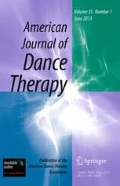Judith Richardson Bunney was introduced to the world of dance at Miss Patricia’s Dance Studio in Denver. As she matured, her interest in ballet and musical theater deepened. In 1953, while attending Benedictine College in Kansas, majoring in psychology and minoring in dance, Judith came across a magazine article about Marian Chace’s dance therapy work with seriously disturbed patients at St. Elizabeths Hospital in Washington, DC.
When she graduated from college, Judith applied for a civil service job as a dance therapist at St. Elizabeths, but no such job designation existed there at the time. Instead, she waited, and learned by chance that Chace also worked part-time at Chestnut Lodge. Judith applied to be Chace’s apprentice at this institution, and held this position for five years.
In 1985, Judith received an MA in public policy from George Washington University. Her clinical career as a dance therapist and dance therapy training officer took place at St. Elizabeths, and spanned the period from 1979 through 2002. While at St. Elizabeths she worked with forensic and gero-psychiatric patients, supervised numerous graduate students enrolled in national and international training programs, and presented her clinical work at many institutions, colleges, and universities worldwide.
Judith’s unique contribution to the ADTA can be characterized as one of stellar and indefatigable service. As a charter member in 1966, she was a pioneering dance therapist in her own right. In 1972 she was elected to the ADTA Board, where she served for two terms as treasurer (1972–1976), followed by two terms as president (1976–1980). While serving her second term as ADTA president, she simultaneously served as president of the National Coalition of Arts Therapies Associations (1978–1981). Her outstanding service to the field of creative arts therapy was recognized by the President’s Commission on Mental Health, which invited her to serve for two years (1977–1979) on a panel charged with exploring the role of the arts in mental health. Judith was instrumental in creating the Government Affairs Committee of the ADTA. She represented the ADTA in federal legislative issues, successfully lobbying for the inclusion of DMT services in PL94-142, a precursor of the current Individuals with Disabilities Education Act.
As the former director of the UCLA graduate DMT program at UCLA, I am particularly indebted to Judith for having co-produced, with Diane Duggan and filmmaker Norris Brock, the film, Dance Therapy: The Power of Movement. I have used this film to introduce graduate students to basic clinical DMT processes and concepts, as well as to introduce potential DMT employers to the unique value of using movement-based therapeutic interventions with a wide range of mental health patients.
Following her retirement from St. Elizabeths in 2002, Judith continued to teach at various dance therapy programs in the Netherlands, the Czech Republic, Poland, Ukraine, and New York. Many of these educational ventures have been in collaboration with dance/movement therapist Miriam Roskin Berger. Judith moved to Santa Fe in 2004; there she resumed her political activism by promoting the environmental agenda of the Sierra Club. She presently serves as a registered lobbyist for this organization.
While Judith and I knew each other superficially through the service we rendered to the ADTA board during the late 1970s and 1980s, it was not until we met each other again, later in life, that we became friends. This happened through a ritual that we gradually and spontaneously created—a week long annual “Opera Ritual” that incorporates fine music, food, and champagne, and allows us to share what currently matters most to each of us in our respective lives.
In 2011, Judith was awarded the ADTA Lifetime Achievement Award. Today, I have the honor of introducing her to you as the presenter of the 2012 Marian Chace Memorial Lecture.
Author information
Authors and Affiliations
Corresponding author
Rights and permissions
About this article
Cite this article
Dosamantes-Beaudry, I. Introduction: Judith Richardson Bunney—Presenter, 2012 Marian Chace Memorial Lecture. Am J Dance Ther 35, 3–4 (2013). https://doi.org/10.1007/s10465-013-9147-0
Published:
Issue Date:
DOI: https://doi.org/10.1007/s10465-013-9147-0

